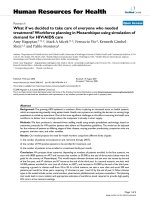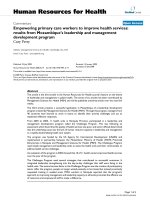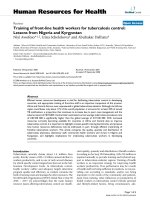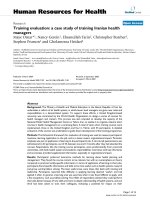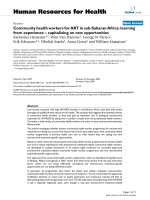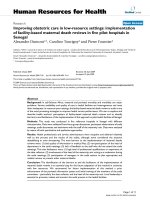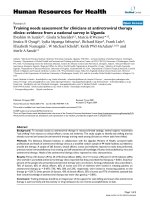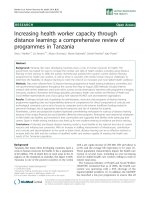báo cáo sinh học:" Training health care workers to promote HIV services for patients with tuberculosis in the Democratic Republic of Congo" pptx
Bạn đang xem bản rút gọn của tài liệu. Xem và tải ngay bản đầy đủ của tài liệu tại đây (314.57 KB, 9 trang )
BioMed Central
Page 1 of 9
(page number not for citation purposes)
Human Resources for Health
Open Access
Research
Training health care workers to promote HIV services for patients
with tuberculosis in the Democratic Republic of Congo
Koen Vanden Driessche
1
, Mulangu Sabue
2
, Wendy Dufour
1
, Frieda Behets
1
and Annelies Van Rie*
1
Address:
1
School of Public Health, University of North Carolina, Chapel Hill, NC 27599-7435, USA and
2
Ecole de Santé Publique, Kinshasa, DR
Congo
Email: Koen Vanden Driessche - ; Mulangu Sabue - ; Wendy Dufour - ;
Frieda Behets - ; Annelies Van Rie* -
* Corresponding author
Abstract
Background: HIV counseling and testing, HIV prevention and provision of HIV care and support
are essential activities to reduce the burden of HIV among patients with TB, and should be
integrated into routine TB care.
Methods: The development of training materials to promote HIV services for TB patients involved
the definition of target health care workers (HCWs); identification of required tasks, skills and
knowledge; review of international guidelines; and adaptation of existing training materials for
voluntary counseling and testing, prevention of mother-to-child transmission of HIV, and
management of opportunistic infections (OIs). Training effectiveness was assessed by means of
questionnaires administered pre- and post-training, by correlating post-training results of HCWs
with the centre's HIV testing acceptance rates, and through participatory observations at the time
of on-site supervisory visits and monthly meetings.
Results: Pre-training assessment identified gaps in basic knowledge of HIV epidemiology, the link
between TB and HIV, interpretation of CD4 counts, prevention and management of OIs, and
occupational post-exposure prophylaxis (PEP). Opinions on patients' rights and confidentiality
varied. Mean test results increased from 72% pre-training to 87% post-training (p < 0.001).
Important issues regarding HIV epidemiology and PEP remained poorly understood post-training.
Mean post-training scores of clinic's HCWs were significantly correlated with the centre's HIV
testing acceptance rates (p = 0.01). On-site supervisory visits and monthly meetings promoted staff
motivation, participatory problem solving and continuing education. Training was also used as an
opportunity to improve patient-centred care and HCWs' communication skills.
Conclusion: Many HCWs did not possess the knowledge or skills necessary to integrate HIV
activities into routine care for patients with TB. A participatory approach resulted in training
materials that fulfilled local needs.
Published: 17 March 2009
Human Resources for Health 2009, 7:23 doi:10.1186/1478-4491-7-23
Received: 6 February 2008
Accepted: 17 March 2009
This article is available from: />© 2009 Driessche et al; licensee BioMed Central Ltd.
This is an Open Access article distributed under the terms of the Creative Commons Attribution License ( />),
which permits unrestricted use, distribution, and reproduction in any medium, provided the original work is properly cited.
Human Resources for Health 2009, 7:23 />Page 2 of 9
(page number not for citation purposes)
Background
The World Health Organization (WHO) estimated that in
2005 alone there were approximately 8.8 million new
tuberculosis (TB) cases and 1.6 million TB deaths, of
which 195 000 occurred among people co-infected with
the human immunodeficiency virus (HIV) [1]. The Dem-
ocratic Republic of Congo (DRC) is ranked as the 11
th
highest globally burdened by TB, with approximately 205
000 new cases annually, of which 20% are estimated to be
among persons HIV co-infected [1,2].
In 2004, WHO published the interim policy on collabora-
tive TB/HIV activities. Key activities are establishing mech-
anisms for collaboration, activities to decrease the burden
of HIV in patients with TB and activities to decrease the
burden of TB in people living with HIV/AIDS [3]. While
many countries have developed training manuals for vol-
untary counseling and testing, prevention of mother-to-
child transmission of HIV, antiretroviral treatment and
treatment of opportunistic infections (OIs), no manuals
for training in collaborative TB/HIV activities for health
care workers (HCWs) at primary health care clinics could
be identified in spring 2005 when scale-up of HIV services
for TB patients was being planned for Kinshasa, capital of
the DRC.
We aimed to develop and evaluate training materials for
provider-initiated HIV counseling and testing, HIV pre-
vention and integrated primary HIV care and support for
HCWs involved in the care of patients with TB at the pri-
mary health care clinic level in the DRC.
Methods
Identification of target health care workers
Primary health care nurses play the central role in TB case
management and were identified as the ideal HCWs to
offer and provide HIV counseling and testing for TB
patients and HIV care and support for those co-infected
with HIV [2,4]. Other HCWs playing a key role in TB con-
trol, including laboratory technicians, physicians and dis-
trict supervisors, were also identified as target HCWs.
Furthermore, to avoid interruption of activities in case of
illness, holidays or reassignments of HCWs, several other
nurses from the primary health care centres were also
selected for training.
HCWs participating in the training were employed at 14
primary health care clinics (under the direction of non-
profit Protestant or Catholic organizations), selected
among all 89 TB clinics in the capital based on criteria of
annual TB case load, existence of some HIV activities and
enthusiasm of the clinic director for project participation
[5].
Development of training materials
Training objectives and materials were developed in col-
laboration with educational specialists, DRC National
HIV and TB Control Program officers, international TB
experts and local HCWs. In a first step, we gained insight
in tasks, skills and knowledge necessary for good perform-
ance from on-the-job experiences of nurses who provided
HIV activities at TB clinics during pilot projects [2]. Sec-
ond, we documented the DRC policy regarding HIV activ-
ities for patients with TB, which included provider-
initiated HIV counseling and testing, HIV prevention, cot-
rimoxazole prophylaxis and referral for antiretroviral
treatment (ART). Third, existing DRC training materials
for HIV counseling and testing, prevention of maternal-
to-child transmission of HIV and management of OIs
were reviewed. Policy guidelines on collaborative TB/HIV
activities and integrated management of adult illnesses
were also consulted [3,6,7]. The new training materials
were developed by focusing on topics that were highly rel-
evant to tasks performed by primary HCWs. The training
was also considered an opportunity to promote patient-
centred care and to provide training on communication
techniques for HCWs.
Evaluating the newly developed training
Participants were asked to complete an assessment of their
knowledge and attitudes pre-training and two weeks after
the training. The structured questionnaire consisted of 38
multiple-choice questions concerning HIV transmission
routes, natural history of HIV, epidemiology of HIV, the
link between TB and HIV, interpretation of CD4 counts,
HIV testing and counseling concepts, universal precau-
tions, cotrimoxazole prophylactic treatment (CPT) and OI
management, occupational post-exposure prophylaxis
(PEP) and opinions on patients' rights and confidential-
ity. To gain further insights, participants were also asked
to provide an explanation for their answer to several key
questions.
Questions addressing the same topic were grouped to cal-
culate a mean test result for each topic. A topic was
believed to be sufficiently understood when the propor-
tion of correct answers was at least 80%. Pearson's Chi-
square test allowed comparison of proportions of correct
answers pre- and post training. Post-training scores of
clinic's HCWs were compared with the clinic's HIV testing
acceptance rate by calculating the Pearson correlation
coefficient.
An educational expert and staff from the national HIV and
TB programmes (n = 5) together with an expert in collab-
orative TB/HIV care, one experienced laboratory techni-
cian and six HIV counsellors participated in the training
Human Resources for Health 2009, 7:23 />Page 3 of 9
(page number not for citation purposes)
sessions to provide feedback. Revision of the training
materials was based on results of the observations made
during the training and the results of the pre-and post-
training assessments of the participants' knowledge and
attitudes.
Participatory observations during on-site supervisory vis-
its and monthly meetings were planned as an integral part
of the training. These activities helped to ensure that tasks
were performed as intended by the training. Supervision
was an opportunity to correct errors because of incompre-
hension or unforeseen circumstances, and to morally sup-
port and motivate the HCW. Supervision was done by a
laboratory technician and four HIV counselors who par-
ticipated in the development and assessment of the train-
ing. A treatment card for collaborative TB and HIV
activities was introduced to record TB/HIV activities and
helped to identify weakness in the performance that
needed attention. The study was reviewed by the Institu-
tional Review Board of the University of North Carolina.
Results
Pre-training knowledge and opinions among HCWs on TB
and HIV
Two groups of HCWs (total n = 67) completed the pre-
training assessment (Fig 1). While most HCWs had ade-
quate knowledge of HIV transmission routes, 7% of par-
ticipants believed HIV was not transmitted through breast
milk and 3% answered that HIV could be transmitted via
mosquito bites. Questions on important concepts such as
the window period in HIV testing, universal precautions
and the natural history of HIV were answered correctly by
most HCWs.
Important gaps were identified and included knowledge
of HIV epidemiology, the link between TB and HIV, the
meaning of CD4 counts, principles of CPT, OI manage-
ment and occupational PEP (Fig 1). The majority (56%)
of participating HCWs substantially underestimated the
burden of HIV in Africa, with 36% participants being con-
vinced that only 10% of people living with HIV reside in
Africa. In contrast, the HIV prevalence in DRC was overes-
timated by almost half (45%) of HCWs, with 15%
answering that more than 30% of the DRC population
was infected with HIV, which is almost 10-fold the Joint
United Nations Programme on HIV/AIDS (UNAIDS) HIV
prevalence estimate of 3.2% for 2005 [8]. Only 11 (16%)
participants answered correctly that, in the DRC, HIV
prevalence is higher among TB patients than in the general
population. Less than half (43%) of the HCWs knew that
lower CD4 counts are associated with more severe immu-
nosuppression. Fourteen (21%) participants did not
know that CPT should be continued when anti-tuberculo-
sis treatment is completed. Only 29 (43%) chose to first
clean the lesion in case of a needle-stick injury.
Opinions on patients' rights and confidentiality varied.
Most HCWs (48, or 72%) believed that a patient's HIV test
result could not be divulged to a colleague when referring
the patient for care (OI treatment), because the test result
is a medical secret. When asked if the HCW has to test all
TB patients for HIV, 44 participants (66%) answered yes,
21 participants (31%) answered no and two participants
left the question open. Most believed this was: "to ensure
good care and follow-up of our patients even after the
treatment of tuberculosis", but two participants answered
"because the HIV test is obligatory" and three others
answered "to develop statistics on HIV among TB
patients". Fifteen (22%) participants did not agree that a
HCW can accept a test refusal because: "Refusing an HIV
test is equivalent to keeping the patient ignorant and that
is discrimination" and "It is for the patient's own good.
The patient should know his serology so he can better pro-
tect himself and prolong his stay on earth."
Content of the training modules
Table 1 details the content of the training. Topics included
HIV epidemiology, transmission modes and natural
course of HIV infection, HIV prevention within the health
care setting (universal precautions), the link between TB
and HIV, the WHO policy on collaborative TB/HIV activ-
ities, provider-initiated HIV counseling and testing in the
TB clinic, care for HIV co-infected TB patients, and moni-
toring and evaluation of HIV activities, including the use
of a modified TB treatment card. Training on the manage-
ment of HIV co-infected TB patients focused on CPT,
nutritional education and psychosocial support. Training
on management of OIs focused on care feasible at primary
health care level and indications for referral, rather than
extensive training on diagnostics. Modules on ART were
not included because of the policy to refer patients for
ART and the extremely limited access to and experience
with ART for patients with TB in the DRC [1].
Topics were introduced using PowerPoint
®
presentations,
interactive question-and-answer sessions, group discus-
sions and case studies, either with the entire group or in
small breakout sessions. HIV counseling was demon-
strated by health care workers experienced in these activi-
ties, followed by practice during role-play sessions in
small groups such that trainees could actively acquire the
new skills. Trainers gave immediate feedback on trainees'
performance during these sessions.
The training materials in French, consisting of a partici-
pant's manual, a trainer's manual, Power Point
®
slides, a
training evaluation questionnaire and the revised treat-
ment card can be obtained from the corresponding
author.
Human Resources for Health 2009, 7:23 />Page 4 of 9
(page number not for citation purposes)
Pre- and post-training HIV and TB knowledge among 67 health care workers involved in TB management in Kinshasa, DRCFigure 1
Pre- and post-training HIV and TB knowledge among 67 health care workers involved in TB management in
Kinshasa, DRC. p-values were obtained by Chi-square testing for difference in proportions. HIV: human Immunodeficiency
virus; TB: tuberculosis; CD4: CD4-positive lymphocytes; CPT: co-trimoxazole prophylactic treatment; OI: opportunistic Infec-
tion; PEP: post-exposure prophylaxis
Human Resources for Health 2009, 7:23 />Page 5 of 9
(page number not for citation purposes)
Table 1: Content of training modules for TB/HIV collaborative activities at the primary health care level.
FIRST TRAINING DAY
Introduction
Module 1: HIV infection
- Differences between HIV and AIDS
- The epidemiology of HIV in the world and DRC
- The immune system and the natural course of HIV infection
- HIV transmission modes
Module 2: Preventing HIV infection
- HIV prevention methods
- Prevention of HIV within the health care setting
Module 3: TB/HIV co-epidemic
- The epidemiology of TB
- The link between TB and HIV
- Reducing the burden of HIV among TB patients
SECOND TRAINING DAY
Module 4: HIV diagnosis
Module 5: HIV counseling and testing in TB treatment centers
- Four types of HIV counseling and testing
- Provider-initiated diagnostic counseling and testing
- Key responsibilities and attitudes of the TB/HIV counselor
- The importance of the 3 Cs in HIV testing
- Basic counseling techniques
- Practice by role play
Module 6: Pre-test counseling for TB patients
- Stages of diagnostic pre test counseling
- Practice by role play
THIRD TRAINING DAY
Module 7: Post-test counseling for TB patients and psychosocial support
- Stages of post-test counseling according to HIV test result
Human Resources for Health 2009, 7:23 />Page 6 of 9
(page number not for citation purposes)
Experience with continuing education and participatory
problem solving
Continuing education, motivation and problem solving
occurred during on-site supervisory visits and monthly
meetings with HCWs actively involved in implementing
HIV activities for patients with TB. Project staff noticed
that, even though the training included role playing to
familiarize HCWs with pre- and post test HIV counseling,
several HCWs felt uncertain about their skills. This prob-
lem was resolved by the presence of trainers on-site during
the first "real life" HIV counseling session. HCWs also
struggled with the reorganization of their daily work
schedule, a necessary step for efficient integration of HIV
counseling and testing into routine patient care. This was
resolved through on-site discussions with the HCW, and
re-evaluated on the next supervisory visit.
Monthly meetings were an opportunity for continuing
education, peer discussion and problem solving. Training
modules for these meetings focused on specific issues
such as family counseling, approach to counseling of
minors, causes and effects of stigmatization, role of sup-
port groups for HIV co-infected patients, community par-
ticipation in HIV and TB prevention and palliative care.
Discussions among HCWs at the meetings mostly con-
cerned approaches to patients who refuse HIV testing at
- Practice by role play
- Psychosocial support
Module 8: Patient flow, recording, monitoring and evaluation
FOURTH TRAINING DAY
Module 9: Management of HIV co-infected TB patients
- Role of the TB service: opportunities and challenges
- Co-trimoxazole preventive therapy
- Nutritional education
- Management of opportunistic infections and other medical problems linked to HIV
(Respiratory problems – Digestive problems/diarrhoea – Neuropsychiatric manifestations – Dermatological manifestations – Oral lesions –
Lymphadenopathies – Fever)
- Referral for care and support
- Introduction to ARV treatment
MONTHLY MEETINGS
Peer discussion and problem solving
Introduction of a specific topic
Module 10: Couple and family counseling
Module 11: HIV counseling of infants, children and adolescents
Module 12: Stigmatization and discrimination
Module 13: Support groups
Module 14: Community mobilization
Module 15: Palliative care
Table 1: Content of training modules for TB/HIV collaborative activities at the primary health care level. (Continued)
Human Resources for Health 2009, 7:23 />Page 7 of 9
(page number not for citation purposes)
TB diagnosis, counseling strategies for patients who refuse
to accept their HIV status, management of patients who
default CPT and strategies to help patients disclose their
HIV status to family members.
Evaluation of the training and revision of the training
manual
High training participation rates were achieved (91% to
100%) at all four consecutive Saturday training sessions
and the training received positive feedback from partici-
pants. Sixty-five (97%) participants completed the post-
training assessment, including 38 nurses, 16 laboratory
technicians, 7 physicians and 4 district supervisors. The
mean test score increased from 72% pre-training to 87%
post-training (p < 0.001). There was no statistically signif-
icant difference in post-training score by type of HCW (p
= 0.19), with a mean post-training score of 87% for
nurses, 86% for laboratory technicians, 89% for physi-
cians and 92% for district supervisors. The mean post-
training scores of clinic's HCWs were significantly corre-
lated with the clinic's HIV testing acceptance rate (Fig. 2).
Post-training, HCWs demonstrated significantly increased
and adequate knowledge of HIV transmission routes, HIV
counseling and testing principles, natural history of HIV,
link between TB and HIV, meaning of CD4 counts, CPT
and management of OIs, patients' rights and the impor-
tance of confidentiality (Fig 1). The only topics for which
the proportion of correct answers remained below 80%
were related to HIV epidemiology and PEP. One third of
participants continued to have difficulties in estimating
the burden of HIV and TB/HIV co-infection in the DRC
and sub-Saharan Africa. Only 43 (66%) participants
answered the PEP questions correctly.
Results of pre- and post-training assessments and observa-
tions made during the training guided the revision of the
initial training manual. Topics that raised confusion or
remained insufficiently understood were revised and
more time was allocated to these topics in the revised
modules. The revised modules were approved by the DRC
National TB Program and used in roll-out of provider ini-
Correlation between mean post-training scores and HIV testing acceptance rate (first 3 months of implementation of HIV activities for TB patients) at 14 primary health care clinics in Kinshasa, DRCFigure 2
Correlation between mean post-training scores and HIV testing acceptance rate (first 3 months of implemen-
tation of HIV activities for TB patients) at 14 primary health care clinics in Kinshasa, DRC.
r = 0.65
p = 0.01
Human Resources for Health 2009, 7:23 />Page 8 of 9
(page number not for citation purposes)
tiated HIV counseling and testing for TB patients in the
DRC.
Discussion
The HIV and TB co-epidemic is one of the most important
public health problems in the African region. Activities to
reduce the burden of HIV among TB patients and activities
to reduce the burden of TB among people living with HIV/
AIDS are therefore urgently needed [3]. HIV counseling
and testing of patients with TB and care for co-infected
patients are key activities in the fight against HIV and TB.
We observed that in Kinshasa, DRC, the vast majority of
HCWs actively involved in TB care did not possess suffi-
cient knowledge or skills to integrate HIV services in TB
clinics, confirming the need for specific training materials.
We developed training materials with careful considera-
tion of the primary health care clinic HCWs' tasks, organ-
ized the necessary knowledge acquisition around these
tasks and used methods that actively involve trainees. The
newly developed training materials filled the identified
gaps in knowledge but came short in transferring coun-
seling skills. However, combined with logistical support,
on-site supervisory visits and monthly continuing educa-
tion meetings, the training allowed the scale-up of HIV
activities for patients with TB at primary health care clin-
ics.
The correlation between mean post-training scores of
clinic's HCWs and the clinic's HIV testing acceptance rate
suggests that the training was effective. But providing a
training course is only one of the many factors needed to
achieve high HIV testing acceptance rates. Other factors
that may play a role include logistic factors, HCW motiva-
tion and the levels of TB and HIV stigma in the commu-
nity [9].
To reinforce the HCWs' capacity in patient management
beyond specific HIV and TB services, we used the training
as an opportunity to integrate concepts of patient-centred
care and communication skills. Communication between
patients and primary care providers is often poor in clini-
cal practice in developing countries [10]. In rural DRC,
health centre clients identified good interpersonal skills as
the most important quality for nurses, followed by good
competence and technical skills [11]. Promoting effective
interpersonal communications during training thus has
the potential to ensure both a high quality of services and
their use by health centre clients [11].
Some limitations to the study should be noted. First, par-
ticipating HCWs were employed at selected primary
health care clinics in the capital. It is possible that the
knowledge prior to the training was higher and not repre-
sentative of all HCWs involved in TB care in Kinshasa. Fur-
thermore, HCWs in the capital are more likely to have
been exposed to HIV and TB messages and training com-
pared to nurses employed in more rural areas. Knowledge
of HCWs in the capital is thus most likely not representa-
tive of the entire country. Second, the post-training assess-
ment evaluated participants' knowledge two weeks after
the training, which is no guarantee of long-term knowl-
edge retention. Finally, while we assessed the individual's
acquisition of knowledge and the clinic level implementa-
tion of the new activities, no formal assessment of an indi-
vidual's acquisition of skills was performed at the end of
the training and the quality of task performance was also
not formally assessed during on-site visits [12]. Several
HCWs needed additional one-on-one training during the
first "real life" HIV counseling session, which argues for
further increasing the focus on transfer of skills, especially
counseling skills.
Conclusion
Integration of HIV activities into routine TB patient care is
urgently needed, but HCWs often do not possess the
knowledge and skills necessary to implement these activi-
ties. The newly developed training was effective in trans-
ferring this knowledge, and was also used as an
opportunity to transfer concepts of patient-centred care
and communication skills in order to improve patient
management beyond HIV and TB care in this resource-
poor setting. Involvement of the National TB and HIV
Program staff in the development phase facilitated the use
of the training materials by the National Program in the
roll-out of TB/HIV training for HCWs involved in TB care
in the DRC soon after completion of the final modules.
Abbreviations
ART: Antiretroviral treatment; CPT: Cotrimoxazole pro-
phylactic treatment; DRC: Democratic Republic of Congo;
HCW: Health care worker; HIV: Human immunodefi-
ciency virus; OI: Opportunistic infection; PEP: Post-expo-
sure prophylaxis; TB: Tuberculosis; UNAIDS: Joint United
Nations Programme on HIV/AIDS; WHO: World Health
Organization.
Competing interests
The authors declare that they have no competing interests.
Authors' contributions
KVD developed the training, collected and analysed the
data and drafted the manuscript. MS carried out the train-
ing for the TB health care workers and helped with its
development. WD and FB also helped with developing
the training. AVR conceived of the study, participated in
developing the training, coordinated the study with FB
and helped to draft the manuscript. All authors read and
approved the final manuscript.
Publish with Bio Med Central and every
scientist can read your work free of charge
"BioMed Central will be the most significant development for
disseminating the results of biomedical research in our lifetime."
Sir Paul Nurse, Cancer Research UK
Your research papers will be:
available free of charge to the entire biomedical community
peer reviewed and published immediately upon acceptance
cited in PubMed and archived on PubMed Central
yours — you keep the copyright
Submit your manuscript here:
/>BioMedcentral
Human Resources for Health 2009, 7:23 />Page 9 of 9
(page number not for citation purposes)
Acknowledgements
Funding was provided by the Centers for Disease Control and Prevention
Global AIDS Program (CDC U62/CCU422422). The content of this report
does not necessarily reflect the views or opinions of the funding agency.
The authors thank the participating health care workers, Ms Karen
Hawkins Reed, Mr Kashamuka Mwandagalirwa, John Ditekemene, Barbara
De Coster and Ms Vera Melotte, for their support. We thank Dr Etienne
Bahati, National Tuberculosis Program, and Dr Jaques Kokolomani,
National AIDS Program, for their support. The authors also thank Martine
Tabala, Felicien Llenda, Richard Mangala, Willy Atungi, Lisette Kapinga,
Adele Mumpassi, and Eugenie Mugoyo. Without their enthusiasm and ded-
ication, this work could not have been carried out.
References
1. World Health Organization: Global Tuberculosis Control: Sur-
veillance, Planning, Financing. Geneva 2007.
2. Van Rie A, Sabue M, Jarrett N, Westreich D, Behets F, Kokolomani J,
Bahati ER: Counseling and testing TB patients for HIV: evalu-
ation of three implementation models in Kinshasa, Congo.
Int J Tuberc Lung Dis 2008, 12(Suppl 1):73-78.
3. World Health Organization: Interim Policy on Collaborative
TB/HIV Activities. Geneva 2004.
4. World Health Organization: Guidance on Provider-Initiated
HIV Testing and Counseling in Health Facilities. Geneva 2007.
5. Martinot A, Van Rie A, Mulangu S, Mbulula M, Jarrett N, Behets F, Bola
V, Bahati E: Baseline assessment of collaborative tuberculosis/
HIV activities in Kinshasa, the Democratic Republic of
Congo. Trop Doct 2008, 38(3):137-141.
6. Harris A, Maher D, Graham S: TB/HIV: a clinical manual 2nd edition.
Geneva: World Health Organization; 2004.
7. World Health Organization: Integrated Management of Adoles-
cent and Adult Illness (IMAI). Geneva 2004.
8. Joint United Nations Programme on HIV/AIDS: 2006 Report on the
Global AIDS Epidemic. Geneva 2006.
9. Corneli A, Jarrett NM, Sabue M, Duvall S, Bahati E, Behets F, Van Rie
A: Patient and provider perspectives on implementation
models of HIV counseling and testing for patients with TB.
Int J Tuberc Lung Dis 2008, 12(Suppl 1):79-84.
10. Unger JP, Van Dormael M, Criel B, Vennet J Van der, De Munck P: A
plea for an initiative to strengthen family medicine in public
health care services of developing countries. Int J Health Serv
2002, 32(4):799-815.
11. Haddad S, Fournier P: Quality, cost and utilization of health
services in developing countries. A longitudinal study in
Zaire. Soc Sci Med 1995, 40(6):743-753.
12. World Health Organization: Task Analysis: The Basis for Devel-
opment of Training in Management of Tuberculosis. Geneva
2005.
